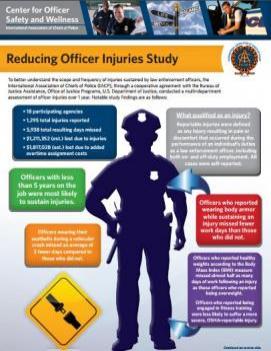Injury Reduction
No injury or death to a law enforcement officer is acceptable, and the IACP is committed to helping instill a culture of safety in every agency, extending from the chief executive to the newest recruit. Understanding and tracking officer injuries are key elements of prevention.
Supporting Officer Safety Through Family Wellness: Injury Reduction

Taking efforts to decrease the likelihood of injury is a crucial part of officer safety and wellness. This infographic discusses the prevalence of injuries and suggestions on how to reduce injuries to both law enforcement officers and their families.
Survivor's Club
Seatbelt Postcard

Too many officers have been killed in traffic related line-of-duty deaths. The Reducing Officer Injury postcard, developed with funding from the Bureau of Justice Assistance, Office of Justice Programs, U.S. Department of Justice, provides statistics, raises awareness, and educates via traffic related safety tips.
Please contact [email protected] to request a postcard.
Seatbelt Decal
Too many officers have been killed in traffic related line-of-duty deaths. The Reducing Officer Injury decal, developed with funding from the Bureau of Justice Assistance, Office of Justice Programs, U.S. Department of Justice, reminds officers to slow down, wear their seatbelt, and refrain from using in-vehicle technologies while driving. Please hand out these decals to your officers to put in their vehicles as a safety reminder.
Please contact [email protected] to request a decal.
Reducing Officer Injuries Study
This 12-month national study of 18 law enforcement agencies sought to examine and quantify the spectrum of injuries sustained by officers. The results documented nearly 1,300 reported injuries, nearly 6,000 missed work days, and nearly $2 million in estimated overtime costs. Examples of key findings include:
-
Officers with less than five years of service were most likely to sustain injuries
-
Officers wearing seatbelts during a crash missed an average of five fewer days compared with officers not wearing seatbelts
-
Officers trained in arrest procedures, tactics, and use of force sustained less severe injuries.
 Final Report |
 Executive Summary |
Infographic |
|
|
|
|
Fact Sheet: The Importance of Tracking Injuries |
Injury Tracking
Tracking Near Misses
The IACP is a partner in the Police Foundation's LEO Near Miss Reporting System, a voluntary, non-disciplinary reporting system that allows law enforcement personnel to read about and anonymously share “close calls” or “near misses,” provide lessons learned that can protect others from similar incidents. A near miss is defined as a close call and/or unsafe occurrence that could have resulted in a serious injury or fatality if not for a fortunate break in the chain of events.
Tracking Injuries by Agency
First steps to reducing injuries is understanding the type, frequency, and causal factors related to injuries
Injuries not only affect individual officers on a personal level but are detrimental to an agency's ability to perform its mission, straining manpower and budgets. Law enforcement agencies should prioritize injury reduction and mitigation and work to achieve a culture of safety within their departments.
One practice that can contribute to organizational culture of safety is tracking injuries sustained by officers while on duty. Detailed and consistent tracking at the agency level allows supervisors and managers to identify common injuries, better evaluate risk, and implement or improve upon agency injury prevention and mitigation policies, practices, and training. Download a simple tool to assist in tracking agency injuries.


